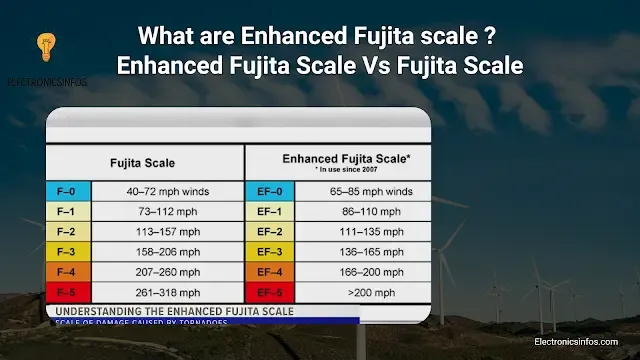What are Enhanced Fujita scale?
The Enhanced Fujita Scale (EF Scale) is a system for classifying tornadoes based on their estimated wind speeds and damage caused. It is an upgrade to the original Fujita Scale, which was developed by Dr T. Theodore Fujita in 1971.
The EF Scale uses a scale of 0 to 5 to rate the intensity of tornadoes based on the damage they cause. The scale takes into account the type and extent of damage to structures such as buildings, as well as the degree of damage to trees and other vegetation.
The EF Scale also considers factors such as the size and shape of the affected area and the duration of the tornado.
The following is a breakdown of the EF Scale ratings
EF Scale
- EF0
- EF1
- EF2
- EF3
- EF4
- EF5
EF0 Scale
Wind speeds of 65 to 85 mph (105 to 137 km/h). Light damage to chimneys, branches, and signs.
EF1 Scale
Wind speeds of 86 to 110 mph (138 to 177 km/h). Moderate damage to roofs, mobile homes, and some trees.
EF2 Scale
Wind speeds of 111 to 135 mph (178 to 217 km/h). Considerable damage to roofs, walls, and mobile homes. Trees are uprooted or snapped.
EF3 Scale
Wind speeds of 136 to 165 mph (218 to 266 km/h). Severe damage to large buildings such as schools and hospitals, as well as homes and mobile homes. Trees are uprooted or snapped.
EF4 Scale
Wind speeds of 166 to 200 mph (267 to 322 km/h). Devastating damage to well-built homes, commercial buildings, and large structures. Trees are stripped of bark and debarked.
EF5 Scale
Wind speeds over 200 mph (322 km/h). Catastrophic damage to homes and commercial buildings, with the complete destruction of some structures. Trees are uprooted or snapped, and objects such as vehicles and large rocks are thrown at great distances.
Advantages of the Enhanced Fujita scale
- The Enhanced Fujita Scale is an improvement over the original Fujita Scale because it takes into account a wider range of damage indicators, such as damage to trees and vegetation, and the size and shape of the affected area.
- The EF Scale allows for easier comparisons of tornadoes across different regions and periods.
- The EF Scale provides a clear and concise way to communicate the intensity of a tornado to the public, emergency managers, and other stakeholders.
- The EF Scale helps meteorologists and emergency managers issue more accurate and timely warnings and advisories to the public.
- The EF Scale provides a useful tool for researchers to study tornadoes and their impacts.
Application of Enhanced Fujita scale
- One of the primary applications of the EF Scale is to provide guidance for issuing tornado warnings.
- The EF Scale is also used to assess the damage caused by tornadoes after they occur.
- The EF Scale provides a useful tool for researchers to study tornadoes and their impacts.
- The EF Scale can also be used to inform building codes and standards for construction in areas prone to tornadoes.
- The EF Scale can also be used by insurance companies to determine the amount of damage caused by a tornado and process claims more quickly and accurately.
Enhanced Fujita Scale Vs Fujita Scale
The Enhanced Fujita Scale (EF Scale) is an updated version of the original Fujita Scale, developed by Dr T. Theodore Fujita in 1971. The EF Scale was developed in response to the need for a more accurate and consistent method for classifying tornadoes based on their wind speeds and the damage they cause.
- The Fujita Scale was based on estimates of wind speeds and damage potential, while the EF Scale uses more accurate wind speed estimates based on actual damage.
- The EF Scale includes a wider range of damage indicators than the Fujita Scale, such as damage to trees and vegetation.
- The EF Scale provides a more consistent method for classifying tornadoes.


.png)



0 Comments
please do not insert spam links